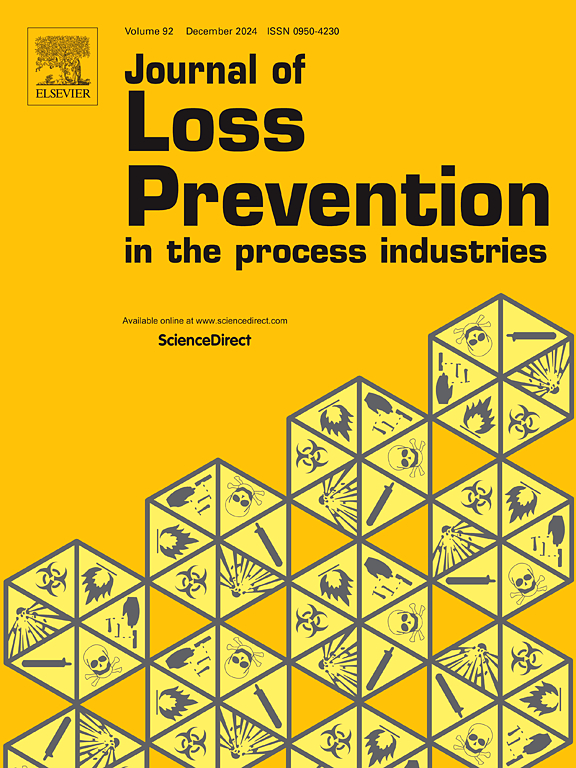Carbon capture with pure monoethanolamine aerosols: Method development for assessing safety hazards and identifying a safe operating window using oxygen-containing flue gas streams
IF 3.6
3区 工程技术
Q2 ENGINEERING, CHEMICAL
Journal of Loss Prevention in The Process Industries
Pub Date : 2025-02-10
DOI:10.1016/j.jlp.2025.105587
引用次数: 0
Abstract
Recent research proved the potential of aerosol reactors for post-combustion capture of CO2 with highly concentrated monoethanolamine (MEA). However, aerosol flammability in a continuous aerosol reactor has not been studied before. Safety cannot be guaranteed when processing oxygen-containing flue gases. The goal of this work is to develop a continuous aerosol safety testing method to investigate aerosol flammability. The proposed method is validated by determining the safe operating window of MEA aerosols by changing parameters on the aerosol and gas side. The relation between aerosol properties and flammability is investigated via high-speed camera. Safe operating conditions in air were found for MEA solutions up to of 70 wt%, suggesting that these solutions are safe to use with any flue gas. However, 80 wt% MEA and higher were flammable. 80 wt% MEA was only flammable at low liquid flow rates. This can be attributed to the increased droplet velocity at higher liquid flow rates, which results in shorter evaporation times. Therefore, the lower flammability limit (LFL) cannot be reached. Overall, MEA concentration and liquid flow rate appear to be the most influential parameters on aerosol flammability. Furthermore, the limiting oxygen concentration (LOC) was investigated. Maximum LOCs were identified as 13.5% and 15% for 100 and 90 wt% MEA, respectively. This information is crucial for matching appropriate flue gases with compatible aerosol reactor configurations. By developing and validating the method for MEA aerosols, this work narrows the gap between aerosol reactors for carbon capture and safely processing oxygen-containing flue gas streams.

使用纯单乙醇胺气雾剂进行碳捕集:开发利用含氧烟气流评估安全危害和确定安全操作窗口的方法
最近的研究证明了气溶胶反应器在燃烧后捕获高浓度单乙醇胺(MEA)二氧化碳的潜力。然而,在连续式气溶胶反应器中,气溶胶可燃性的研究还没有进行过。处理含氧烟气时,不能保证安全。本工作的目的是开发一种连续的气溶胶安全测试方法来研究气溶胶的可燃性。通过改变气溶胶侧和气体侧的参数,确定MEA气溶胶的安全运行窗口,验证了该方法的有效性。利用高速摄像机研究了气溶胶特性与可燃性之间的关系。对于高达70% wt%的MEA溶液,发现了空气中的安全操作条件,这表明这些溶液可安全用于任何烟气。然而,80%的MEA和更高的是可燃的。80wt %的MEA仅在低液体流速下可燃。这可以归因于在较高的液体流速下液滴速度的增加,从而导致蒸发时间的缩短。因此,无法达到低可燃性极限(LFL)。总的来说,MEA浓度和液体流速似乎是影响气溶胶可燃性的最重要参数。此外,还研究了极限氧浓度(LOC)。对于100 wt%和90 wt%的MEA,最大loc分别为13.5%和15%。这一信息对于将适当的烟气与相容的气溶胶反应器配置相匹配至关重要。通过开发和验证MEA气溶胶的方法,这项工作缩小了用于碳捕获的气溶胶反应器与安全处理含氧烟气流之间的差距。
本文章由计算机程序翻译,如有差异,请以英文原文为准。
求助全文
约1分钟内获得全文
求助全文
来源期刊
CiteScore
7.20
自引率
14.30%
发文量
226
审稿时长
52 days
期刊介绍:
The broad scope of the journal is process safety. Process safety is defined as the prevention and mitigation of process-related injuries and damage arising from process incidents involving fire, explosion and toxic release. Such undesired events occur in the process industries during the use, storage, manufacture, handling, and transportation of highly hazardous chemicals.

 求助内容:
求助内容: 应助结果提醒方式:
应助结果提醒方式:


